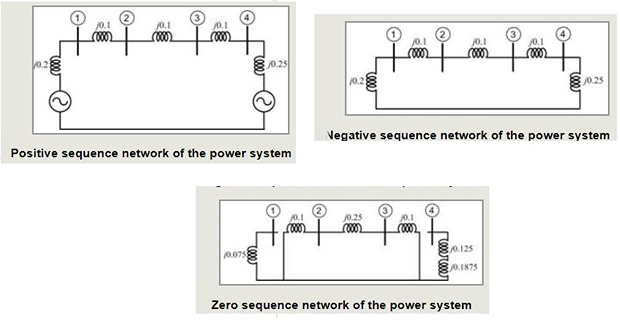Demonstrative Video
Fault Current Computation Using Sequence networks
Demonstrate the use of sequence networks in the calculation of fault currents
- \[ \begin{aligned} \text{Generator}~ G & : 50~ MVA, 20 kV, X" = X_1 = X_2 = 20\%, ~X_0 = 7.5\% \\ \text{Motor}~ M & : 40~ MVA, 20 kV, X" = X_1 = X_2 = 20\%, ~X_0 = 10\%, Xn = 5\% \\ \text{Transformer}~ T_1 & : 50 MVA, 20~ kV ~\varDelta /110 ~kV~ Y,~ X = 10\% \\ \text{Transformer}~ T_2 & : 50 MVA, 20~ kV~ \varDelta /110~ kV ~Y,~ X = 10\% \\ \text{Transmission line} & : X_1 = X_2 = 24.2 ~\Omega, ~ X_0 = 60.5 ~\Omega \end{aligned} \]: (a) LG, (b) LL and (c) LLG fault occurs at bus-2 Find
Let us choose a base in the circuit of the generator. Then the per unit impedances of the generator are:
\[X_{G1} = X_{G2} = 0.2, ~~ X_{G0} = 0.075\]- \[X_{T1} = X_{T2} = 0.1\]the per unit impedances of the two transformers are
The MVA base of the motor is 40, while the base MVA of the total circuit is 50. Therefore the per unit impedances of the motor are
\[\begin{aligned} X_{M1} = X_{M2} = & 0.2 \times \dfrac{50}{40} = 0.25 \\ X_{M0} = & 0.1 \times \dfrac{50}{40} = 0.125 \\ X_n = & 0.05 \times \dfrac{50}{40} = 0.0625 \end{aligned}\]
- \[Z_{base} = \dfrac{110^2}{50} = 242~\Omega\]\[X_{L1} = X_{L2} = \dfrac{24.2}{242} = 0.1, ~~ X_{L0} = \dfrac{60.5}{242}= 0.25\]For the transmission line
Let us neglect the phase shift associated with the \(Y/ \varDelta\) transformers. Then the positive, negative and zero sequence networks are

- \[Y_{bus1}=Y_{bus2}=j\left[\begin{array}{cccc} -15 & 10 & 0 & 0\\ 10 & -20 & 10 & 0\\ 0 & 10 & -20 & 10\\ 0 & 0 & 10 & 14 \end{array}\right]\]matrix for both positive and negative sequences we get the following
- \[Z_{bus1}=Z_{bus2}=j\left[\begin{array}{cccc} 0.1467 & 0.1200 & 0.0933 & 0.0667\\ 0.1200 & 0.1800 & 0.1400 & 0.1000\\ 0.0933 & 0.1400 & 0.1867 & 0.1333\\ 0.0667 & 0.1000 & 0.1333 & 0.1667 \end{array}\right]\]matrix Inverting the above matrix we get the following
For the zero sequence
\[\begin{aligned} Y_{bus0}& =j\left[\begin{array}{cccc} -13.333 & 0 & 0 & 0\\ 0 & -14 & 4 & 0\\ 0 & 4 & -14 & 0\\ 0 & 0 & 0 & -3.2 \end{array}\right]\\ \Rightarrow Z_{bus0}&=j\left[\begin{array}{cccc} 0.075 & 0 & 0 & 0\\ 0 & 0.0778 & 0.0222 & 0\\ 0 & 0.0222 & 0.0778 & 0\\ 0 & 0 & 0 & 0.3125 \end{array}\right] \end{aligned}\]- \[Z_1 = Z_2 = j0.18, ~~ Z_0 = j0.0778\]For fault in bus-2, the Thevenin impedances
- \[\begin{aligned} Z_1 = & Z_2 = j0.3 ~\parallel~ j0.45 = j0.18 \\ Z_0 = & j0.1 ~\parallel~ j0.35 = j0.0778 \end{aligned}\]Alternatively from Figure
\(\bullet\)
- \[I_{fa0} = I_{fa1} = I_{fa2} = \dfrac{1}{j\left(2\times 0.18 + 0.0778 \right)} = -j2.2841 ~pu\]Let a bolted 1LG fault occurs at bus-2 when the system is unloaded with bus voltages being 1.0 per unit. Then
- \[I_{fa}= 3I_{fa0} = -j6.8524~pu\]Also,
- \[\begin{aligned} V_{2a0} = & -j0.0778I_{fa0} = -0.1777\\ V_{2a1} = & 1-j0.18I_{fa1} = 0.5889\\ V_{2a2} = & -j0.18I_{fa2} = -0.4111\\ \end{aligned}\]. We get the sequence components of the voltages as Also,
\(\bullet\)
- \[I_{fa1} = -I{fa2} = \dfrac{1}{j2 \times 0.18} = -j2.7778 ~pu\]For a bolted LL fault, we can write
- \[\left[\begin{array}{c} I_{fa}\\ I_{fb}\\ I_{fc} \end{array}\right]=C^{-1}\left[\begin{array}{c} 0\\ I_{fa1}\\ I_{fa2} \end{array}\right]=\left[\begin{array}{c} 0\\ -4.8113\\ 4.8113 \end{array}\right]\]Then the fault currents are
- \[\begin{aligned} V_{2a0} = & 0\\ V_{2a1} = & 1-j0.18 I_{fa1} = 0.5\\ V_{2a2} = & -j0.18 I_{fa2} = 0.5 \end{aligned}\]Finally the sequence components of bus-2 voltages are
- \[\left[\begin{array}{c} V_{a}\\ V_{b}\\ V_{c} \end{array}\right]=C^{-1}\left[\begin{array}{c} V_{2a0}\\ V_{2a1}\\ V_{2a2} \end{array}\right]=\left[\begin{array}{c} 1.0\\ -0.5\\ -0.5 \end{array}\right]\]Therefore the voltages at the faulted bus are
\(\bullet\)
- \[Z_{eq} = j0.18 \parallel j0.0778 = j0.0543\]Let us assume that a bolted 2LG fault occurs at bus-2. Then,
- \[I_{fa1} = \dfrac{1}{j0.18+Z_{eq}} = -j4.2676 ~pu\]The positive sequence current is
- \[\begin{aligned} I_{fa0} = & -I_{fa1} \dfrac{j0.18}{j(0.18+0.0778)} = j2.9797~pu \\ I_{fa2} = & -I_{fa1} \dfrac{j0.0778}{j(0.18+0.0778)} = j1.2879~pu \end{aligned}\]The zero and negative sequence currents are then computed
- \[\left[\begin{array}{c} I_{fa}\\ I_{fb}\\ I_{fc} \end{array}\right]=C^{-1}\left[\begin{array}{c} I_{fa0}\\ I_{fa1}\\ I_{fa2} \end{array}\right]=\left[\begin{array}{c} 0\\ 6.657\angle137.11^{0}\\ 6.657\angle42.89^{0} \end{array}\right]\]Fault currents flowing in the line are
- \[\begin{aligned} V_{2a0} & =-j0.0778I_{fa0}=0.2318\\ V_{2a1} & =1-j0.18I_{fa1}=0.2318\\ V_{2a2} & =-j0.18I_{fa2}=0.2318 \end{aligned}\]Sequence components of bus-2 voltages are
- \[\left[\begin{array}{c} V_{a}\\ V_{b}\\ V_{c} \end{array}\right]=C^{-1}\left[\begin{array}{c} V_{2a0}\\ V_{2a1}\\ V_{2a2} \end{array}\right]=\left[\begin{array}{c} 0.6954\\ 0\\ 0 \end{array}\right]\]Therefore the voltages at the faulted bus are
: assume that 2LG fault has occurred in bus-4 instead bus-2
- \[X_1 = X_2 = j0.1667, ~~X_0 = j0.3125\]Then
- \[Z_{eq} = j0.1667 \parallel j0.3125 = j0.1087\]We have
- \[I_{fa1} = \dfrac{1}{j0.1667+Z_{}eq} = -j3.631~pu\]Hence
- \[\begin{aligned} I_{fa0} & = -I_{fa1}\dfrac{j0.1667}{j(0.1667+0.3125)} = j1.2631~pu \\ I_{fa2} & = -I_{fa1} \dfrac{j0.3125}{j(0.1667+0.3125)} = j2.3678 ~pu \end{aligned}\]Also
- \[\left[\begin{array}{c} I_{fa}\\ I_{fb}\\ I_{fc} \end{array}\right]=C^{-1}\left[\begin{array}{c} I_{fa0}\\ I_{fa1}\\ I_{fa2} \end{array}\right]=\left[\begin{array}{c} 0\\ 5.5298\angle159.96^{0}\\ 5.5298\angle20.04^{0} \end{array}\right]\]Therefore the fault currents flowing in the line are
We shall now compute the currents contributed by the generator and the motor to the fault.
Let us denote the current flowing to the fault from the generator side by \(I_g\), while that flowing from the motor by \(I_m\).
Using the current divider principle, the positive sequence currents contributed by the two buses are
\[\begin{aligned} I_{ga1} & =I_{fa1}\times\dfrac{j0.25}{j0.75}=-j1.2103~pu\\ I_{ma1} & =I_{fa1}\times\dfrac{j0.5}{j0.75}=-j2.4206~pu \end{aligned}\]Similarly from Fig., the negative sequence currents are given as
\[\begin{aligned} I_{ga2} & =I_{fa2}\times\dfrac{j0.25}{j0.75}=-j0.7893~pu\\ I_{ma2} & =I_{fa2}\times\dfrac{j0.5}{j0.75}=-j1.5786~pu \end{aligned}\]
- \[\begin{aligned} I_{ga0} & = 0\\ I_{ma0} & = j1.2631~pu \end{aligned}\]Finally zero sequence current flowing from the generator to the fault is 0. Then we have
- \[\left[\begin{array}{c} I_{ga}\\ I_{gb}\\ I_{gc} \end{array}\right]=C^{-1}\left[\begin{array}{c} I_{ga0}\\ I_{ga1}\\ I_{ga2} \end{array}\right]=\left[\begin{array}{c} 0.4210\angle-90^0\\ 1.7445\angle173.07^{0}\\ 1.7445\angle6.93^{0} \end{array}\right]\]Therefore the fault currents flowing from the generator side are
- \[\left[\begin{array}{c} I_{ma}\\ I_{mb}\\ I_{mc} \end{array}\right]=C^{-1}\left[\begin{array}{c} I_{ma0}\\ I_{ma1}\\ I_{ma2} \end{array}\right]=\left[\begin{array}{c} 0.4210\angle90^0\\ 3.8512\angle154.07^{0}\\ 3.8512\angle25.93^{0} \end{array}\right]\]and those flowing from the motor are
It can be easily verified \(I_g + I_m = I_f\)